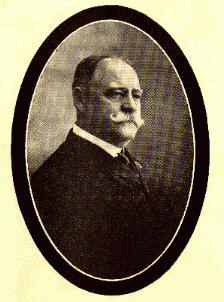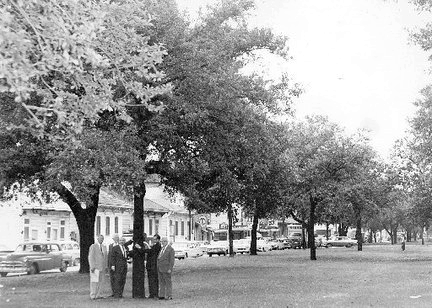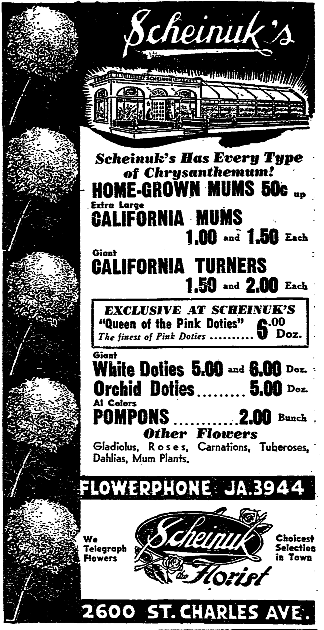
Warren Easton Becomes Superintendent
of New Orleans Public Schools
October 11, 1888
 Born in New Orleans on November 19, 1848, Warren Easton graduated from Louisiana State University in 1871, taught in Baton
Rouge schools for two years, and returned to New Orleans to teach at
Born in New Orleans on November 19, 1848, Warren Easton graduated from Louisiana State University in 1871, taught in Baton
Rouge schools for two years, and returned to New Orleans to teach at Magnolia, Jackson, St. Philip, and
Fillmore
Public School of which he became principal. From 1884 to 1888 he served as Louisiana
Superintendent of Education. In that position Easton established the State Normal School in Natchitoches (which
is now Northwestern State University).
On October 11, 1888, he was elected Superintendent of New Orleans Public Schools and served
until his death in 1910. At that time the system had 414 teachers of 24,800 students in 51 schools. In 1910, when
Easton died in office, there were 1,122 teachers, 38,098 students in day classes, and 87 schools (105 teachers of 4,035 students
worked at nine night schools).
During his twenty-two-year tenure Easton launched classes in calisthenics, drawing, and music. He submitted the first
typewritten superintendent's report on January 11, 1889. On November 2, 1905, forty young men
enrolled in public schools' first short-hand, typing class. On October 15, 1894 Easton inaugurated
fire drills in schools, and on September 25, 1906 he required compulsory smallpox vaccinations
of students.
Easton fought to set regular paydays
for teachers and endorsed and established the Teachers' Pension League. He organized the Louisiana Teachers Association
and served as its president. He was active in the National Education Association, New Orleans Educational Association,
and the Public School Alliance. Married to Camille Hart, he died in New Orleans on October 17, 1910 and is interred
at Greenwood Cemetery.
Warren Easton school was named
for him in 1911. Principal Francis Gregory and the entire faculty moved into the new school at 3019 Canal Street.in
1913. In 1952 the school became co-ed and in 1967 was racially integrated.Warren Easton school celebrated its 100th year
anniversary of the opening its current location on September 16, 2013.
Students of note
who attended Warren Easton include Henry Boh (Class of 1911), O. Perry Walker (Class of 1918), Mayor Victor Schiro (Class
of 1922), Harold "Hoss" Memtsas (Class of 1932), John T. Curtis, Sr. (Class of 1938), Cosimo Matassa (Class of 1941),
Eddie Price (Class of 1943), Al Belleto (Class of 1944), Pete Fountain (Class of 1945), Lester Kennedy Class of 1950), Sheriff
Charles Foti, Jr. (Class of 1953), Ronald McDonald (Class of 1954), and Lee Harvey Oswald.


Writer, literary critic, and editor for The New York Times, Anatole Paul Broyard (born in New Orleans
on July 16, 1920) died on October 11, 1990.
Fort Macomb at Chef Menteur Pass, built in the 19th-century, was added to the National Register
of Historic Places on October 11, 1978.
Elise Scheinuk Passes Away
October 11, 1967
Married in Galviston, Texas in 1908, Max and Elise Scheinuk moved to New Orleans the same
year and started the business in New Orleans in 1909. First located at 4433 Dryades Street they opened a shop at 2047 Broadway
(corner of Panola) during the mid 1910s and advertised as "The Broadway Florst".
Max had served as an active member of the city Parkway Commission and as a member of the board of directors
of the Jewish Children's Home, the Southern Florest Association, and the New Orleans Horticultural Society Floral Association.
a native of Poland, he died in New Orleans on May 15, 1974 at the age of 88.
Elise,
a native of Germany, came to the U.S. in 1906. She passed away on October 11, 1967 at the age of 80.
Their business at 2600 St. Charles Avenue also served as their home. Their nursery was on Jefferson Higway near Kenner.
Pictured on the right, an October 29, 1954 Times-Picayune advertisement for
Scheinuk's St. Charles Avenue florist shop.
 Max Scheinuck, served as chairman of the ground committee
which sought to save as many oak trees as possible when the Interstate highway was planned to run along Claiborne Avenue. From the Times-Picayune:
Max Scheinuck, served as chairman of the ground committee
which sought to save as many oak trees as possible when the Interstate highway was planned to run along Claiborne Avenue. From the Times-Picayune: The designated route of Interstate 10 through New Orleans called for it to run
along North Claiborne Ave. On Nov. 14, 1961, city officials met on the avenue's neutral ground at Dumaine St. to mark its
oak trees that were to be "saved." They are, from left, Herman Farley, president of Parks and Parkway Commission;
Wilson S. Callender of New Orleans Floral Trail; Mayor Victor Schiro; Felix Seeger, commission superintendent, and Max Scheinuck,
chairman of the ground committee.
Only 51 of the 253 trees
from Canal St. to Elysian Fields Avenue were deemed salvageable in a move The Times-Picayune editorialized was "indispensable
to general progress." Removal of the trees did not occur until February 1966. Many cite the destruction of this leafy
boulevard and its vibrant community life as start of Treme's downward spiral. Removal of this stretch of the interstate
has been suggested in several post-Hurricane Katrina plans.
Born on September 26, 1918, Fred James Cassibry received a B.A. from Tulane University
in 1941 and an LL.B. from Tulane Law School in 1943. After serving in the Navy during World War II he became a field examiner
for the National Labor Relations Board from 1946 to 1948. He entered private practice in New Orleans from 1948 to 1961, and
was a New Orleans City Councilman from 1954 to 1961. He was a judge on the Civil District Court for Orleans Parish from
1961 to 1966. On October 11, 1966, Cassibry was nominated by President Lyndon B. Johnson to a new seat
on the United States District Court for the Eastern District of Louisiana created by 80 Stat. 75. He was confirmed by the
United States Senate on October 20, 1966, and received his commission on November 3, 1966. He assumed senior status on March
15, 1984, serving in that capacity until his retirement on April 3, 1987. He died on July 6, 1996.
Binding Books
October 11, 1937
October 11, 1937 -- Legal documents bound by WPA Bookbinding
Project.
In 1937 the federal Works Progress Administration employed workers in
New Orleans who were cleaning, repairing, and/or rebinding 100 books per day. They had received 21, 687 textbooks from
seven cities near New Orleans. Three-hundred people were employed in the state at an estimated cost of $200,000 including
$9000 for materials. State Superintendent of Schools T.H. Harris wrote that it is "one of the most important projects
the federal government is undertaking". James H. Crutcher, state WPA administrator said the project "Saves
Louisiana tax payers thousands of dollars". By 1938, 66,830 discarded textbooks had been cleaned and repaired.
In 10 parishes, 5,335 people were employed, in this "white collar"
program, who sorted 59,224 case reports at Charity Hospital, thousands of volumes for the New Orleans Public Library, the
archives of the Cabildo and City Hall, 15,000 veterans' grave records, and 12,923 service records. The data from 800,000 observations
of atmospheric balloon flights were recorded, currents and tides were indexed. New Orleans traffic problems were surveyed.
Workers modernized the city tax office by processing 183,687 pages of tax record books. A toy lending center was established
where workers repaired 1528 toys and created 8,825 more. Other workers reconditioned 1574 pieces of furniture for distribution
to underprivileged homes and made clothing for persons on relief rolls at 10 different locations. Alma S. Hammond was
the state director of this Professional and Service Division. (Photo from http://nutrias.org/~nopl/photos/wpa/wpa09.htm)
Henry L. Fuqua, 38th Governor of
Louisiana, who defeated defeated Huey Pierce Long, Jr., in the Democratic gubernatorial primary of 1924, died in office
on October 11, 1926. He was succeeded by Oramel H. Simpson. In 1916, Fuqua became the warden of the
Louisiana State Penitentiary at Angola. He held the position until he became governor.
Walter C. Flower, the 44th mayor of New Orleans (from April 27, 1896 – May 7, 1900), died
at his country home in Covington on October 11, 1900 at the age of fifty. He is buried in Metairie
Cemetery.
On December 1, 1898, Ormond plantation was purchased by State Senator Basile LaPlace, Jr., son of New Orleans pharmacist and land owner after whom the town of LaPlace
is named. Mr. LaPlace was a well-known Justice of the Peace and then as a state Senator, and also successfully managed the
LaPlace land area left to him by his father. Legend has it that on the night of October 11, 1899, Basile
LaPlace, Jr. was shot and hung from one of the oak trees on the property by members of the
Ku Klux Klan after a prior disagreement, according to http://en.wikipedia.org/wiki/Ormond_Plantation_House.
Abel Ware Bosworth established an ice business in New Orleans in 1845. He was elected major
of the Crescent Infantry Regiment on March 5, 1862 and fought in the Battle of Shiloh. He was promoted to the rank
of colonel of his regiment on October 27, 1862 and appointed colonel of the Consolidated Crescent Regiment, April 1864, which
he commanded until the end of the Civil War. He was President of Crescent City Ice Company, Vice president of Mutual National
Bank, and an unsuccessful candidate for mayor in 1882 on the Independent and People's parties' tickets. He later became
a planter on Bayou Teche and died on his plantation on October 11, 1885. (From http://lahistory.org/site19.php
James Henry Caldwell, a native of Manchester, England,
after working as an actor in England and the United States and having managed a theater in Alexandria,
Virginian (in 1818) and built a theater at Petersburg, built the Camp Street Theater in New Orleans at cost of $70,000 and
although it was still not finished, opened it on May 14, 1823. It was the first important structure in the new Second (American)
Municipality. It formally opened on January 1, 1824. Meanwhile, Caldwell continued to tour eastern theaters during
summer until 1825 at which time he began tours of towns in the South and Southwest—called "Pioneer of Drama in
the South." Brought competent actors and good plays to the region and became the most important theatrical person
there. Built theaters in Cincinnati, Nashville, Mobile, and converted a salt house in St. Louis into a theater. He introduced
gas lighting into American Theater in New Orleans and organized a company to supply gas lighting for the city, receiving
a charter on March 1, 1833. It began operations in 1834 but Caldwell sold his interest in 1835. He established similar
companies in Cincinnati and Mobile and these were his principal sources of wealth in later years. He opened the St. Charles
Theater in New Orleans on November 12, 1835; it was the most magnificent theater in the South and one of the largest in
the country but it burned in March, 1842. Caldwell retired from theatrical activity on January 14, 1843, and thereafter
devoted his time to several official positions in New Orleans. He was commissioned as
captain in Louisiana Militia, Forty-second Regiment of First Brigade on December 7, 1842. He was a member of the Second
Municipality Council during the last ten years of its existence and then served as recorder. When New Orleans reverted
to one complete city government, he was elected to board of aldermen and served as president of that body from 1855-1856.
He served a term in the Louisiana house of representatives (1858-1860) and in 1857, became a principal stockholder in Bank
of James Robb. He had extensive real estate holdings in New Orleans and elsewhere. Caldwell left New Orleans
between February and October, 1862 to live in Cincinnati. In August of 1863 he was living in New York City. In feeble health
for some time, he died there on September 11, 1863. Services were held on September 14, at St. Patrick's Cathedral. His
remains were then taken back to New Orleans where services were again held on October 11, 1863, at Dead
Church [?] on Rampart St. with burial in Fireman's Cemetery. (From http://lahistory.org/site20.p)
When Union troops were on the verge of invading New Orleans, Confederates quickly removed millions of
dollars of gold to a "safer" location, the city of Columbus, Georgia. The gold was temporarily stored at the Iron
Bank by William H. Young. On October 11, 1862, General P.G.T. Beauregard was ordered to take the gold from
Young's bank in Columbus. Young refused to release it, but was compelled to do so by force. According to Beauregard's biography,
"What became of that coin is a mystery."
On the Fourth of July, 1858, Senator Jefferson Finis Davis, future President of the Confederate States
of America, delivered an anti-secessionist speech on board a ship near Boston. He again urged the preservation of the
Union on October 11, 1858 in Faneuil Hall, Boston.




 Born in New Orleans on November 19, 1848, Warren Easton graduated from Louisiana State University in 1871, taught in Baton
Rouge schools for two years, and returned to New Orleans to teach at
Born in New Orleans on November 19, 1848, Warren Easton graduated from Louisiana State University in 1871, taught in Baton
Rouge schools for two years, and returned to New Orleans to teach at 



